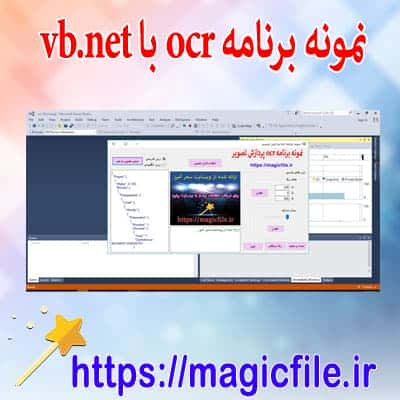OCR IN VB.NET: A COMPREHENSIVE EXAMPLE
OCR، که مخفف "تشخیص کاراکتر نوری" است، تکنولوژیای است که به ما اجازه میدهد متون چاپی یا دستنویس را به دادههای دیجیتال تبدیل کنیم. برای پیادهسازی OCR در VB.NET، میتوانیم از کتابخانههای مختلفی استفاده کنیم. یکی از محبوبترین آنها Tesseract است.
راهاندازی پروژه
ابتدا، یک پروژه جدید VB.NET در Visual Studio ایجاد کنید. پس از ایجاد پروژه، باید Tesseract را به پروژه خود اضافه کنید. میتوانید این کار را از طریق NuGet Package Manager انجام دهید.
- NuGet Package Manager:
- گزینه "NuGet Package Manager" را انتخاب کنید.
- بر روی "Manage NuGet Packages for Solution" کلیک کنید.
- در قسمت جستجو، "Tesseract" را وارد کنید و آن را نصب کنید.
کدنویسی
در اینجا یک مثال ساده از چگونگی استفاده از Tesseract در VB.NET آورده شده است:
```vb
Imports Tesseract
Module Module1
Sub Main()
Dim ocrEngine As New TesseractEngine("C:\Program Files\Tesseract-OCR\tessdata\", "eng", EngineMode.Default)
Using img As Pix = Pix.LoadFromFile("C:\path\to\your\image.png")
Using page As Page = ocrEngine.Process(img)
Dim text As String = page.GetText()
Console.WriteLine("Recognized Text: " & text)
End Using
End Using
End Sub
End Module
```
توضیحات کد
- Imports Tesseract: این خط کتابخانه Tesseract را وارد میکند.
- TesseractEngine: شیٔی برای پردازش تصویر و تشخیص متن ایجاد میکند. مسیر دادهها و زبان مورد نظر را تعیین میکند.
- Pix.LoadFromFile: تصویر را بارگذاری میکند. مطمئن شوید که مسیر تصویر صحیح است.
- Process: تصویر بارگذاری شده را پردازش میکند و متن شناسایی شده را برمیگرداند.
- GetText: متن شناسایی شده را استخراج میکند.
نکات پایانی
- دقت OCR: کیفیت تصویر تأثیر زیادی بر دقت OCR دارد. تصاویر با وضوح بالا بهترین نتایج را میدهند.
- زبانهای مختلف: میتوانید زبانهای مختلف را با دانلود فایلهای دادههای مربوطه از وبسایت Tesseract اضافه کنید.
این یک مقدمهی ساده بر استفاده از OCR در VB.NET بود. با این اطلاعات، شما میتوانید به راحتی پروژههای خود را با استفاده از تکنولوژی OCR بهبود بخشید.
OCR VB.NET EXAMPLE: A COMPLETE AND DETAILED GUIDE
Optical Character Recognition (OCR) is a technology that enables the conversion of different types of documents—like scanned paper documents, PDFs, or images—into editable and searchable data. Using OCR in VB.NET allows developers to integrate this functionality seamlessly into their applications, whether for automating data entry, digitizing printed documents, or building intelligent search systems.
BASIC OVERVIEW OF OCR IN VB.NET
At its core, implementing OCR in VB.NET involves:
- Selecting an OCR library or SDK: Several options exist, such as Tesseract OCR, MODI (Microsoft Office Document Imaging), or commercial SDKs like ABBYY FineReader SDK.
- Loading the image: Importing the image or document that needs to be processed.
- Configuring OCR settings: Adjusting language, DPI, or recognition mode.
- Executing recognition: Processing the image to extract text.
- Handling the output: Saving or displaying the recognized text for further use.
USING TESSERACT OCR WITH VB.NET
Among the most popular open-source solutions is Tesseract OCR. It’s free, highly accurate, and supports multiple languages. Here’s a detailed step-by-step example:
- INSTALL Tesseract OCR AND NECESSARY LIBRARIES
- Download Tesseract OCR from its official repository.
- Add Tesseract wrapper for .NET, like Tesseract OCR for .NET, via NuGet Package Manager.
```bash
Install-Package Tesseract
```
- PREPARE THE IMAGE
Ensure your image is clear, with high contrast, and at a suitable resolution (preferably 300 DPI or higher). Save it locally or load directly from a stream.
- WRITING THE VB.NET CODE
Here's a comprehensive example:
```vb.net
Imports Tesseract
Public Class OCRExample
Public Sub RecognizeText()
Try
' Initialize Tesseract engine with language data
Using engine As New TesseractEngine("tessdata\", "eng", EngineMode.Default)
' Load image file
Using img As Pix = Pix.LoadFromFile("sample_image.png")
' Process the image
Using page As Page = engine.Process(img)
' Extract text
Dim result As String = page.GetText()
' Display or store the recognized text
Console.WriteLine("Recognized Text: " & result)
End Using
End Using
End Using
Catch ex As Exception
Console.WriteLine("Error: " & ex.Message)
End Try
End Sub
End Class
```
EXPLANATION OF THE CODE
- Engine Initialization: The `TesseractEngine` is initialized with the path to the `tessdata` folder and language code (`eng` for English). You must download language data files and place them in the specified directory.
- Loading Image: The `Pix.LoadFromFile()` method reads the image.
- Processing: The `engine.Process()` method performs OCR.
- Output: The `page.GetText()` method retrieves recognized text.
- Error Handling: Try-catch blocks handle potential runtime errors, such as missing files or bad images.
ADDITIONAL TIPS AND NOTES
- Language Support: For other languages, download respective `.traineddata` files and specify the language code.
- Image Preprocessing: Enhance images using filters, thresholding, or deskewing to improve accuracy.
- Batch Processing: Loop through multiple images for batch OCR tasks.
- Performance Optimization: Use multithreading for large-scale or real-time OCR.
CONCLUSION
Integrating OCR into VB.NET projects can significantly automate and enhance data processing workflows. Whether you opt for open-source options like Tesseract or commercial SDKs, understanding the core concepts—loading images, configuring recognition, and handling output—is essential. With this comprehensive example, you’ve got a solid starting point to build robust OCR solutions tailored to your needs.
If you'd like, I can help you set up a complete project or troubleshoot specific issues. Just let me know!





